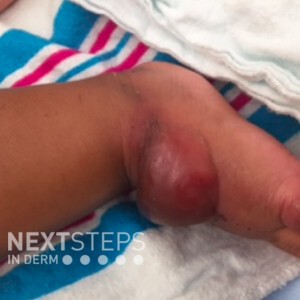
The correct answer is A. Necrosis of sweat glands.
Coma bullae are predominantly subepidermal. However, intraepidermal blisters are also observed as the result of re-epithelialization of older lesions or epidermal spongiosis. There is a variable degree of epidermal necrosis. Sweat gland necrosis is a characteristic finding, and focal necrosis of the epithelium of the pilosebaceous follicles can also be seen. There is only a sparse inflammatory cell infiltrate. DIF is usually negative, but deposits of IgG, IgM and/or C3 have been found within the walls of dermal blood vessels.
Incorrect answers:
2-Coma bullae are predominantly subepidermal. However, intraepidermal blisters are also observed as the result of re-epithelialization of older lesions or epidermal spongiosis.
3-Coma bullae are predominantly subepidermal. However, intraepidermal blisters are also observed as the result of re-epithelialization of older lesions or epidermal spongiosis.
4-There is only a sparse inflammatory cell infiltrate.
5- DIF is usually negative, but deposits of IgG, IgM and/or C3 have been found within the walls of dermal blood vessels.
References:
AH Chacon, U Farooq, S Choudhary, et al.: Coma blisters in two postoperative patients. Am J Dermatopathol. 35:381-384 2013 PMID 23334516
